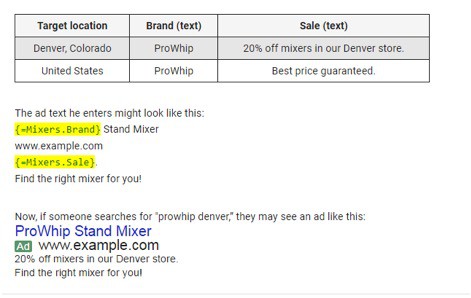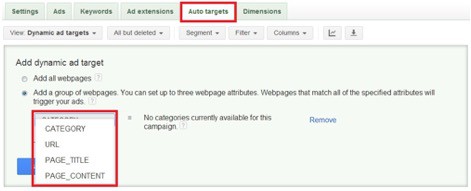AdWords IF functions and Ad customisers
Large AdWords accounts with hundreds of products, prices, and special offers are extremely time-consuming to manage manually. Constant changes take away from time to truly strategise on an account, requiring hours instead on tactical changes. However, with customisers in AdWords, management time is cut down significantly for PPC experts and you can reach customers with highly relevant ads in real time.
There are several strategies PPC experts can use to make AdWords campaigns more personalised, including ad customisers and IF functions. Both have a similar feel to dynamic keyword insertion and are more personalised for searchers.

Ad Customisers
To use ad customisers, PPC experts upload a spreadsheet into the Shared Library in Google AdWords as seen below. This holds the business data that will be dynamically inserted into the ads.

Google offers a spreadsheet template to use for business details such as the product info, pricing and promotion details. When this data is uploaded, what shows dynamically in the ad text is what customers are searching for items that matches data in your spreadsheet. Hotels use this strategy to show daily prices for the best deals. Airlines display up to date route availability and pricing using ad customisers. Using this in conjunction with the COUNTDOWN function to have an end date for promotions creates that sense of urgency.

Think about feeds as a customer database with relevant information about products and services, such as title, category, and URL. Just as your customer database is not static, once feeds are uploaded, they need be updated regularly in the Business Data section of the AdWords Shared Library. If you neglect your feed, your product information is no longer fresh so people may attempt to purchase something that is out of stock. Either generate new versions of product feeds and re-upload or use the AdWords API if the data changes frequently.
In the below case study, see how Airbnb used customisers to stay top of mind in the moment that matters.
www.youtube.com/watch?v=dgYt2Fn4fn4
Showing this dynamic information in ads, such as prices and inventory, results in efficient management, tailored ads, and a sense of urgency. And with ad group-level ad customisers, PPC experts can add the same template to each ad group for real time updates showing specific information. There is the need for only one creative that will change dynamically. Customisations can go even further with an IF function.
IF functions
IF functions are another way to personalise the AdWords experience and do not require a feed. “IF functions allow you to insert a specific message in your text ad when a condition is met, and a default text when it does not. This makes your ads tailored to each search and more relevant to potential customers.”
Currently, PPC experts can use this to target based on a device or an audience, showing different copy depending who is served the ad. For mobile users, advertisers may want emphasise how easy their checkout process is on a mobile device. Those targeting an audience may have a specific message to visitors who abandoned a shopping cart with a special offer for them to return and complete their purchase. Note that IF functions can only be used in the headlines or description, not the URL.
Location customisers
But what about location based micro-moments when people turn to a device to find something very quickly, such as with Airbnb? Locations matter for things such as finding the closest gas station with a low price or a place to stay. Brick and mortar businesses do not want to spend time duplicating data for each separate location in their paid ads which is very difficult to maintain.
Location targeting data feeds are based on location of presence – meaning where someone is physically located – and the location of interest which is a geographic term included in the search query. With location ad customisers, the interest of the searcher trumps the physical location.
These are also uploaded as Business Data in the Shared Library of Google AdWords for businesses who want to target specific cities. Google offers a template for this data too, making it easy for PPC experts to create different entries for each city of interest. Since searches including the term “nearby” have increased significantly, this provides an opportunity for smaller, local businesses to stand out from larger national competitors.
This is a huge time saver since the inserted ad copy depends on a user’s location and removes the need for separate budgets for different locations or to managed location-specific ad groups. Additional use cases include highlighting shipping rates and length of time for delivery for different parts of the country, addressing network coverage for telecom services, a product push based on the climate such as warm coat versus bathing suits, and availability by location.
Once you have uploaded your business data, you will still need to have a standard text ad in your group before setting up ads with your location customisers – or any customizer. Ads will not show at all if you are missing a standard text ad. Your customizer ads will include data from your spreadsheets with different messaging based on the location. The below example shows a promotion when the location of interest – Denver – is used in the search query.

Dynamic Search Ads
One final piece of customisation are Dynamic Search Ads. Search queries evolve, businesses expand, and inventory changes which make Dynamic Search Ads a great solution for constant changes. This allows PPC experts to reach customers without maintaining a keyword list. Ads are served when a searcher uses keywords that are found on your website. AdWords will automatically crawl a site to find relevant terms and connect with users in an efficient way and target automatically based on landing pages. Overall, this reduces the frequency of changes for account managers.
Dynamic Search Ads feature custom headings and landing pages based on a user’s search. If a search is relevant to the content of your website, Google will automatically create an ad to enter the auction based on product and services. You can even see which headlines are being displayed and how they are performing in the Auto Targets tab.

Google AdWords also offers several options with Dynamic Search Ads to target groups based on user behaviour.
- Use recommended categories to target based on the content of your website and relevant landing pages.
- Create an all webpages dynamic ad target to ensure you will cover all relevant queries to your site where you also have a relevant landing page. This overlaps with other targets in your account and queries that match more than one dynamic search ad will favor the more specific target. You can set lower bids for less specific traffic and exclude traffic you may not want.
- Separate out high-value dynamic ad targets after campaigns have run for a while. You may discover some targets perform better others.

Consumers have more choices today than ever before and want to know what’s in it for them. If your ad does not promise to meet their need, they can very quickly find a business who does. By reaching them where they are, such as on a mobile device, and based on their location of interest, you are generating personalised ads that answer the question “What’s in it for me?” and more likely to turn that prospect into a customer. As with all features in Google AdWords, take time to test these specific Customisations just as you would with any other A/B testing in your account.
